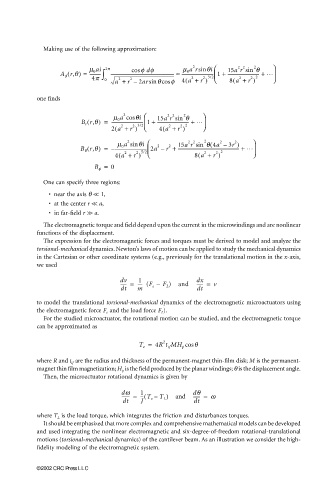Page 650 - The Mechatronics Handbook
P. 650
0066_Frame_C20.fm Page 120 Wednesday, January 9, 2002 1:47 PM
Making use of the following approximation:
2 2 2 2
m 0 ai 2p cos f df m 0 a rsin qi 15a r sin q …
(
A f r,q) = ---------- ∫ --------------------------------------------------------- ≈ ---------------------------- 1 + ---------------------------- +
4p 0 a + r – 2arsin qcos f 4 a +( 2 r ) 8 a +( 2 r )
2 2
2 3/2
2
2
one finds
2
2 2
m 0 a cos qi 15a r sin 2 q …
(
B r r,q) = ---------------------------- 1 + ---------------------------- +
2 2
2 3/2
2
(
(
2 a + r ) 4 a + r )
2
2 2
(
2
2
2
m 0 a sin qi 2 2 15a r sin 2 q 4a – 3r )
B q r,q( ) = – ---------------------------- 2a – r + ------------------------------------------------------- + …
2 5/2
2 2
2
4 a +( 2 r ) 8 a + r )
(
B f = 0
One can specify three regions:
• near the axis θ << 1,
• at the center r << a,
• in far-field r >> a.
The electromagnetic torque and field depend upon the current in the microwindings and are nonlinear
functions of the displacement.
The expression for the electromagnetic forces and torques must be derived to model and analyze the
torsional-mechanical dynamics. Newton’s laws of motion can be applied to study the mechanical dynamics
in the Cartesian or other coordinate systems (e.g., previously for the translational motion in the x-axis,
we used
dv 1 dx
----- = ---- (F − F ) and ------ = v
dt m e L dt
to model the translational torsional-mechanical dynamics of the electromagnetic microactuators using
the electromagnetic force F e and the load force F L ).
For the studied microactuator, the rotational motion can be studied, and the electromagnetic torque
can be approximated as
2
T e = 4R t tf MH p cos q
where R and t tf are the radius and thickness of the permanent-magnet thin-film disk; M is the permanent-
magnet thin film magnetization; H p is the field produced by the planar windings; θ is the displacement angle.
Then, the microactuator rotational dynamics is given by
dw 1 dq
------- = -- T e –( T L ) and ------ = w
dt J dt
where T L is the load torque, which integrates the friction and disturbances torques.
It should be emphasized that more complex and comprehensive mathematical models can be developed
and used integrating the nonlinear electromagnetic and six-degree-of-freedom rotational-translational
motions (torsional-mechanical dynamics) of the cantilever beam. As an illustration we consider the high-
fidelity modeling of the electromagnetic system.
©2002 CRC Press LLC

